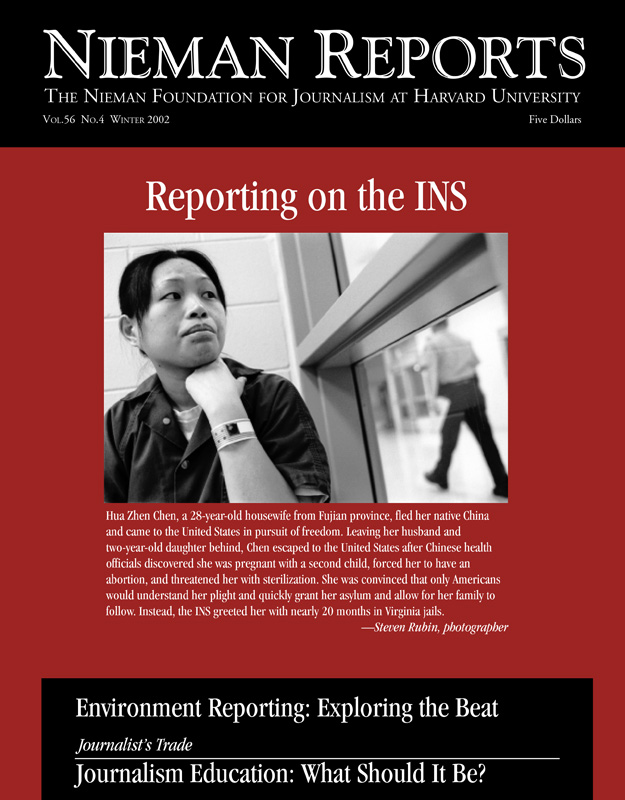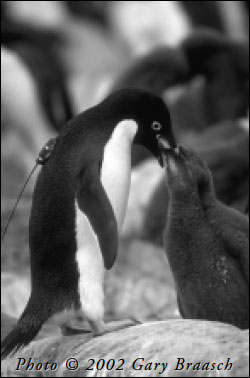Climate change is happening. I have seen it with my own eyes.
I have stood in the empty rookeries of displaced Adelie penguins and felt the chill of huge icebergs separating from a receding ice shelf on the Antarctic Peninsula. I saw the young black spruces growing higher than ever before on boreal hillsides in Alaska and witnessed subtle changes on the tundra. I can see the ablation of glaciers near my home in the Pacific Northwest and have photographed again the 150-year-old images of great Swiss glaciers to show them wasting away. In North America I’ve photographed early blooming plants and migrating birds arriving sooner than expected. Along the coasts I have seen rising tides and heavy storms erode beaches and felt the anguish of native Alaskans as their village is increasingly washed away.
These and other observations were made beginning in 1999 as part of my photographic project, “World View of Global Warming.” I wanted to move beyond the raw statistics, the charts, and the predictions that are easily dismissed. I wanted to look at the earth itself, with the eyes of a natural history photographer, and report on what changes were already underway. It seemed to me that despite the accumulating scientific evidence of the circumstances and potential consequences, awareness about this issue was largely absent from political debate, rarely written about, and seldom talked about around kitchen tables. A visual connection was needed.
In the years since then, I’ve crossed both the Antarctic and Arctic Circles, ventured above 15,000 feet in the Andes to photograph receding glaciers, dove on damaged coral reefs with scientists monitoring ocean warming, and followed scientists into the field in Europe and North America. I found that physical systems like oceans and glaciers are being altered. Animals and plants, adapted during thousands of years to strict relationships of temperature, moisture and food availability, have no choice but to respond to changes in their habitat. In remote locations and in familiar gardens and parks, scientists are devoting their careers to measure what is happening, documenting the effects of global warming, and interpreting the results.
What I saw and learned on my photographic journeys offers strong confirmation of the global warming predictions we have been hearing since the mid-1980’s. The sources I used for guidance and documentation are hundreds of peer-reviewed studies in scientific journals and sections of the Intergovernmental Panel on Climate Change report and interviews with scientists. The scientific evidence has become a little better known in the past few years and, earlier in 2002, was acknowledged in the Environmental Protection Agency’s policy paper “Climate Action Report 2002,” even as President Bush persisted in opposing the Kyoto Protocol on limiting greenhouse gases.
Photographing and reporting on these effects presents a great challenge. These changes have been unfolding for 50 years or more. Each year, the effects are incremental, small and subtle, if not literally invisible. But after more than three years visiting scientists and their research sites my photographs have accumulated incremental effects of their own. The evidence these photographic images offer has proven compelling, even to skeptics. They have been published widely, from Time, Life and Discover to textbooks, environmental Web sites, and exhibits.
But can any photographs “prove” that global warming is a fact? The pictures, like the natural science they depict, certainly don’t render courtroom proof. Rather they offer evidence of tight correlations among, and long-term observations of, physical events. Most of these photographs require captions to make their point strongly, but with this assistance, the story line they illustrate does start to clearly emerge.
Photography’s message is strengthened because the effects of global warming are frequently seen in earth’s most beautiful and sensitive landscapes, at the poles, in the mountains, and on the edges of plant and animal ranges. Treasured and threatened ecosystems and creatures can be shown in their transitions.
I have come to understand that I am documenting one of the crucial, overarching events of the 21st century. As global warming exacerbates overpopulation, food crises, and coastal degradation, its consequences might affect more people than did war in the last century. Whatever the human role, there are six billion of us on the planet now, deeply interconnected and affected by environmental changes. We are going to have to live with them and reduce activities that make them worse.
This is a magnificent and urgent story just beginning to be told. In time, each of us will see it.
Gary Braasch’s climate project is facilitated by 501(c)(3) tax status through the Blue Earth Alliance of concerned documentary photographers. The project has a Web site at www.worldviewofglobalwarming.org.



